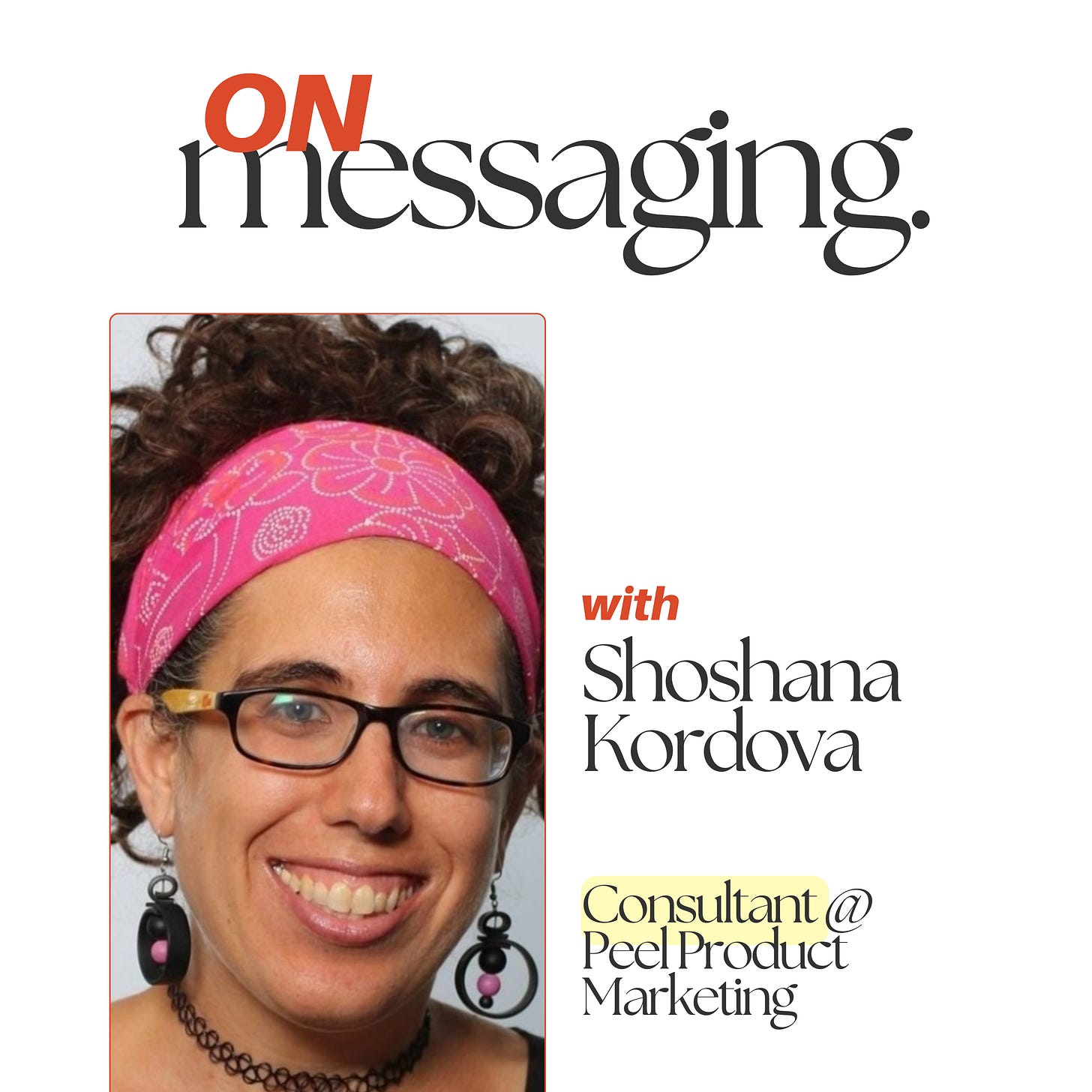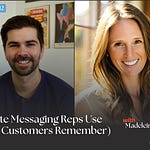Listen now of YouTube, Spotify, and Apple Podcasts!
On the show today, I have Shoshana Kordova, creator of Peel Product Marketing.
She truly defines what it means to be a curious product marketer and I think you’ll see what I mean throughout our conversation.
Shoshana has an extensive career as a writer and editor. She’s contributed to The Washington Post, Smithsonian, and The New York Times just to name a few 🤯
This episode is for product marketers who…
Are coming from a writing or editing background and how that experience is a huge plus
You’re looking to run customer interviews that go beyond surface level
How to create messaging for very technical products
How to understand the core needs of sales and why they are asking for enablement
Why it’s about understanding the story first, then the telling
How to break into product marketing at a high tech start up
And so much more.
Here are the key themes and ideas from my time with Shoshana:
What is your approach to figuring out the kind of messaging that will resonate with an audience, especially in the context of working with startups?
Resonating messaging begins with active listening. This involves engaging with internal stakeholders across the company (product, sales, customer success, leadership) to understand their perspectives on customer needs and the company's value proposition.
I view product marketing as the intersection of product capabilities and market needs.
Therefore, understanding both sides is crucial. More importantly, I prioritize speaking directly with the target audience and existing customers to understand their challenges, goals, and how the product fits into their lives.
It's about uncovering the "why" behind their need for a solution and the ultimate objectives they are trying to achieve.
By understanding these two endpoints, the product capabilities and the market needs, you can then build compelling stories that resonate.
What are some core questions you ask internal teams like sales and customer success to inform your messaging?
Instead of relying on a rigid checklist, my questions are driven by what I want to learn from each team.
For sales, I primarily want to understand their communication with prospects – what they are saying and what they are hearing in response.
I also want to identify gaps in their tools and resources (sales enablement). It's not just about getting a list of desired materials like one-pagers, but understanding the "why" behind their requests, the context in which they would be used in the customer lifecycle, and the ultimate purpose they aim to serve.
For customer success, I focus on how customers are actually using the product, why it's important to them, and the goals they are achieving with it.
You emphasize the importance of talking to customers. What specific information are you trying to extract from these conversations to enhance your messaging?
With customers, I'm particularly focused on understanding the "before and after" – what their situation was like before they started using the product, what problem they were trying to solve, and why they even began looking for a solution.
I want to understand the process they went through, why they chose our product over competitors, and what they would have done without it.
This helps identify the gaps our product fills and its true value. Uncovering this "before" scenario is critical for crafting messaging that speaks to prospects currently in that stage.
Also, by understanding their previous processes and the impact of our product, we can often uncover ROI metrics that the customers themselves may not have explicitly calculated.
These conversations often yield valuable competitive intelligence by understanding why customers may have rejected competitors or what they disliked about previous solutions.
How do you create clear and concise messaging for complex high-tech products without "dumbing it down" and still highlighting their unique value?
The key is to always frame the messaging from the customer's perspective. Instead of starting with features, technology, or algorithms, focus on the benefits and outcomes for the customer.
Understand what the technology enables the customer to do that they couldn't do before and how it helps them reach their goals. Continuously asking "how does this help the customer?" is essential, even for individual features.
Once you understand the customer context, you can articulate the value proposition in terms of their needs. Often, it's not necessary to explain all the technical intricacies; focus on the aspects that directly impact the customer and help them understand how the product solves their problems.
Tailoring the level of technical detail to the specific audience within the buying committee (e.g., IT vs. end-users) is also crucial. Sometimes, conveying the "aha moment" visually, like using a GIF to demonstrate the product in action, can be more impactful than lengthy technical explanations.
How do you effectively bring storytelling into your messaging?
Storytelling in product marketing begins long before the actual writing. It stems from the deep understanding of how product capabilities meet market needs, which is gained through the research and conversations we've discussed.
By understanding the customer's journey, their challenges, their "before and after," and the goals they achieve with the product, you have the raw materials for a compelling story.
It's about putting the puzzle pieces together – understanding both what the product can do and what the market needs.
Once this underlying story is clear, you can then craft messaging for various platforms and stages of the funnel.
Often, the most impactful stories emerge from customer interviews, revealing unexpected benefits and use cases. The product marketing "collateral factory" (focusing solely on output like web pages and decks) is secondary to the foundational work of understanding the core narrative.
For someone new to product marketing or messaging, what is one piece of advice you would offer, and what is a common mistake to avoid?
One crucial piece of advice is to be relentlessly curious. This involves asking questions, even if they seem basic, and persistently digging deeper by asking follow-up questions or rephrasing the same question until you truly understand the underlying needs and realities.
Be curious about both the product's capabilities and the market's needs. A common mistake to avoid is relying on jargon.
Jargon often masks a lack of deep understanding. If you can't explain something simply, it's likely you don't fully grasp it.
Focus on understanding the core value proposition so clearly that you can articulate it in plain language that resonates with your audience. Also, don't underestimate the value of listening – truly listening – to both internal teams and, most importantly, your customers and prospects.
Here’s what’s covered in our conversation:
00:00 Introduction to Shoshana Kordova's Journey
03:31 Transitioning from Journalism to Product Marketing
06:13 The Importance of Research and Interviewing
08:51 Understanding Messaging through Customer Insights
11:32 The Role of Internal Stakeholders in Messaging
14:19 Exploring Customer Needs and ROI
17:03 Peeling the Onion: Digging Deeper in Conversations
19:44 Crafting Clear Messaging for High-Tech Products
24:57 Understanding Diverse Messaging Needs
29:10 The Power of Visual Storytelling
34:25 Crafting Compelling Stories in Marketing
38:13 Mentoring and Building Confidence in Product Marketing
44:59 Key Messaging Takeaways and What Living is All About
Where to find Shoshana:
Website: https://app.assetmule.ai/vVFtTvys
LinkedIn: https://www.linkedin.com/in/shoshana-kordova/
How To Get Insights From Customer Interviews (Playbook #7): https://jetpack.productivepmm.com/playbooks/playbook-7-customer-insights-and-messaging
Where to find Josh:
LinkedIn: https://www.linkedin.com/in/joshua-chronister/
Substack:
YouTube: https://www.youtube.com/@OnMessaging
Referenced:
Haaretz: https://www.haaretz.com/
Amanda Natividad: https://www.linkedin.com/in/amandanat/
Steven Dubner: https://www.linkedin.com/in/stephen-dubner-2a066578/
Freakonomics Podcast: https://freakonomics.com/podcasts/
Washington Post: https://www.washingtonpost.com/
The New York Times: https://www.nytimes.com/
The Smithsonian: https://www.si.edu/
Marketo: https://business.adobe.com/products/marketo.html
Hubspot: https://www.hubspot.com/
Gong: https://www.gong.io/
Peel Product Marketing: https://app.assetmule.ai/vVFtTvys
Created by Josh Chronister
I interview the best product marketers and tech companies who create messaging that resonates with their buyers. Come learn from them, so you can hit ‘Publish’ with confidence.














